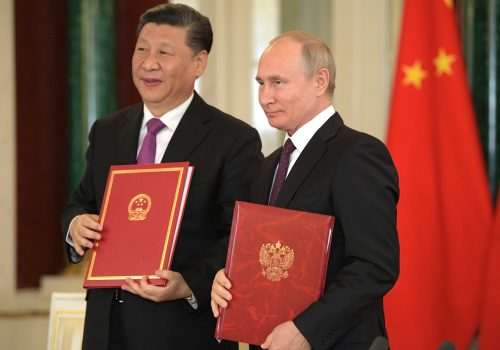
February 22, 2024 • 4:39 pm ET
Chinese exports have replaced the EU as the lifeline of Russia’s economy
Two years after Putin’s invasion of Ukraine, Russia’s external trading relationship has stabilized. Following a drastic collapse of more than 50 percent of imports in the immediate aftermath of the attack, Russian imports have seemingly returned to their 2019 average. Integral to this recovery is the booming trading relationship between Moscow and Beijing. While Chinese exports to the rest of the world have grown by 29 percent since 2021, Chinese exports with Russia over the same period have risen by over 121 percent. Beijing is now a key supplier of both industrial and consumer goods, helping Moscow keep its domestic economy afloat as it sustains the war effort in the face of G7 punitive economic measures.
In the immediate aftermath of the invasion, a combination of G7 sanctions and export controls, as well as broad moral outrage, caused Western exports to fall some 63 percent from their pre-COVID, 2019 average. Though G7 exports to Russia did make a slight recovery in the second half 2022, they have since fallen to new lows. In the final months of 2023, G7 exports to Russia were valued at just 28 percent of their 2019 average. Since then, however, Moscow has been able to substitute its long standing trading relationships with the G7, and most importantly the EU, with China. Today, China exports more to Russia than the entire European Union (EU), Russia’s former largest trading partner, did pre-COVID.
However, the EU and broader G7 coalition are still sending Russia around $3.2 billion of dollars in goods a month in 2023. What are they still selling to Russia? And what are the products that Beijing is producing and trading with Russia that have since made it Moscow’s most important trading partner?
What is the G7 still trading with Russia?
Over the past two years, a coalition of countries, dominated and led by the G7, has implemented the largest sanctions and export controls regime ever imposed on a major economy. This has severely restricted, and in some cases halted, the export of a range of goods to Russia including aviation and space equipment, raw materials, and certain industrial machinery.
In addition to suspension in trade of explicitly controlled items, more than 1,000 companies have voluntarily restricted their operations in Russia or engagement with Russian firms and consumers beyond the minimum legal requirements. The combined impact of this has been a precipitous drop in trade between Russia and the West with exports dropping from around $9.3 billion a month in 2019 to $3.2 billion a month in 2023.
While total exports from the G7 to Russia fell by around 65 percent in the first eleven months of 2022 when compared with the same time period in 2019, certain goods categories were more impacted than others. In line with the formally-controlled goods categories, the strongest-hit export categories were transportation goods such as air and spacecraft falling 99.6 percent, boats falling 99.4 percent and cars falling 83 percent; raw materials such as iron and steel falling 92 percent; chemicals such as dyes and paints falling 93.3 percent; electrical machinery and electronics 90 percent; and rubber falling 87 percent. (For a full overview see the table.)
Many of the least-impacted goods were either foodstuffs and pharmaceuticals—two categories that are exempt from sanctions or export controls to avoid causing humanitarian crises. Total G7 food and animal product exports have still fallen by around 15 percent from 2019 to 2023 though pharmaceutical exports remain the same from 2019.
The EU has felt the brunt of these trade restrictions. Though the United States has experienced a larger percentage drop in export value—falling 90 percent from $484 million a month in 2019 to $48 million a month in 2023—the absolute effects were relatively benign for an economy that, in 2019, exported $212 billion a month. In contrast, for many EU member states like Latvia and Lithuania, Russia still is an important export market. In 2019, EU exports comprised 85 percent of total G7 exports to Russia, or around $7.7 billion a month. By 2023, monthly EU exports had fallen by nearly $5 billion to $2.9 billion a month.
This exemplifies the disproportionate economic impact the war in Ukraine has had on European countries compared to the broader G7. It also explains EU resistance to additional G7 trade restrictions, such as efforts last year to shift the current sector-by-sector controls regime to a complete export ban with only a few exemptions.
What is China now exporting to Russia?
As Russia’s importing relationships stabilized throughout 2023, it has become increasingly clear that new Chinese exports to Russia have replaced the lost EU imports. While EU exports have fallen by just under $5 billion a month from 2019 to 2023, Chinese exports have risen by just over $5 billion a month growing from $3.9 billion to $9 billion a month over the same time period.
Most of the West’s attention has been rightfully focused on surging Chinese exports of raw material inputs and finished industrial goods. This isn’t surprising. Russia needs these products, like rubber, chemicals, and plastics, to sustain its wartime economy. China has also become the main machinery shipper to Russia, with a nearly 129 percent increase in exports over the first nine months of 2023 from the same period in 2019. However, Chinese exports have not fully replaced Russia’s lost G7 exports.
While Chinese machine exports have surged by $1.9 billion a month in 2023, G7 exports have fallen by $2.1 billion dollars a month compared with 2019. These are the goods most important to Russia’s war effort, and it has been able to recover most (but not all) of what it lost. Based on data from Brugel’s Russian foreign trade tracker, Russia’s imports of categories that capture goods subject to G7 controls are now around 75 percent their 2019 average meaning that Russia is still unable to import key dual-use and industrial equipment from China and other alternative trading partners.
But this is only one part of the story. Nearly half of the goods China shipped to Russia in 2023 are consumer goods, not industrial ones. Just as Russian factories are now dependent on Chinese inputs, Russian households are increasingly dependent on Chinese-made apparel, toys, and even office equipment. Many Russians have been forced to swap out the western fashion houses of Paris, London, and Milan for Shanghai’s suits and Fujian’s footwear. They are also now driving Chinese cars: Chinese vehicle exports are 900 percent higher in 2023 compared to the same time frame 2019.
Russia’s overwhelming reliance on Chinese industrial and consumer imports have increasingly suggested the Russia-China relationship is no longer an equal partnership. Instead, Russia is increasingly playing the role of an economic vassal to China. Moscow has little choice but to turn to Beijing for its large economy, technological prowess, and global clout. While the relationship is certainly asymmetric in China’s favor, Moscow is a rare bright spot in Beijing’s souring global trading relationships. In 2023 Chinese exports globally fell by 5 percent compared with 2022. In contrast, Chinese exports to Russia grew 46 percent. As China faces large domestic industrial overcapacity issues, an increasingly hostile trading environment from its traditional export markets such as the EU, and a return to export oriented growth, Russia is a vital release valve to absorb Chinese products, supporting Beijing’s own domestic economy.
Because of the importance of Moscow as an export market, as well as Beijing’s own strategic interests regarding the war in Ukraine, it’s unlikely Chinese President Xi Jinping will yield to Western pressure to halt its broad exports to Russia. Additionally, after two years of conflict, the G7 have implemented almost all available sanctions and export controls against Russia that could reach consensus within the group. As the final few months of 2023 demonstrate, Russia’s global trading relationships are beginning to stabilize. China imports will still rise just as G7 imports will continue to fall, though not nearly with the same intensity as during the first eighteen months of the conflict. As the war enters its third year, there is less and less that can be done on the import side of Russia’s trade balance. Instead, the G7 will likely increase focus on stemming Moscow’s ability to pay for its imports by focusing on the other half of Russia’s trade balance and restricting its exports and the payments it receives from them.
Niels Graham is an associate director for the Atlantic Council GeoEconomics Center where he supports the center’s work on China’s economy and US economic policy.

At the intersection of economics, finance, and foreign policy, the GeoEconomics Center is a translation hub with the goal of helping shape a better global economic future.
Further reading
Mon, Jan 23, 2023
Russian finance pivots east
Econographics
By
Niels Graham
Starting in 2014 and accelerating after Russia’s invasion of Ukraine, Moscow launched a financial pivot toward China. While it initially worked for both countries, economic stress in China as well as the risk of overreliance on Beijing may hinder its future success
Image: Chinese President Xi Jinping greets Russian President Vladimir Putin as they attend the opening ceremony of the Belt and Road Forum (BRF), to mark the 10th anniversary of the Belt and Road Initiative at the Great Hall of the People in Beijing, October 18, 2023. REUTERS/Edgar Su TPX IMAGES OF THE DAY







